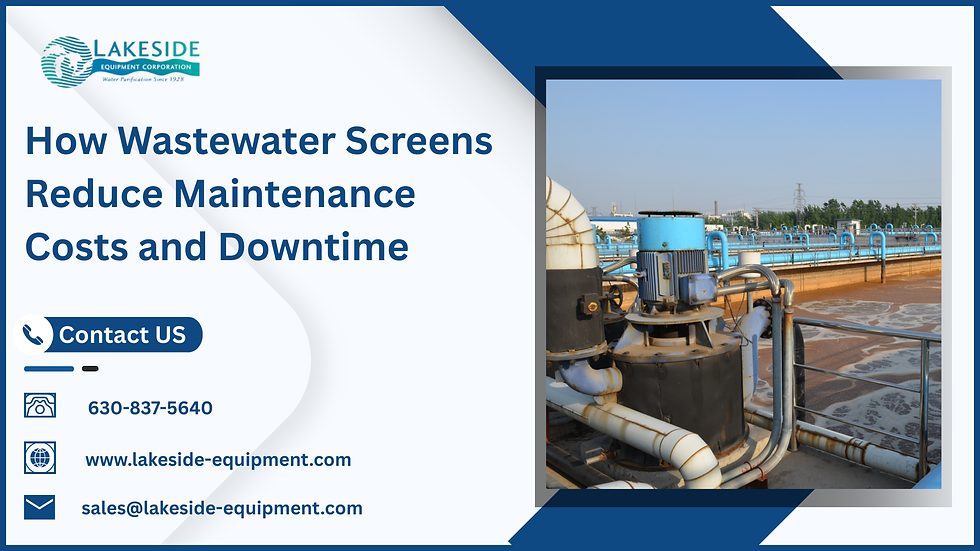How Breakthroughs In Wastewater Bar Screen Systems Are Changing The World?
- lakesideequipment

- Jun 21, 2023
- 3 min read
The effective removal of solid waste is crucial in the field of wastewater treatment. In this procedure, wastewater bar screen systems are essential because they serve as the first line of defense to keep big debris out of treatment facilities. This blog examines the innovations and improvements in sludge screening systems or technologies, illuminating the importance of wastewater bar screens in preserving the reliability and efficiency of wastewater treatment procedures.
Understanding Wastewater Bar Screens
A. What are Wastewater Bar Screens?

In order to stop and remove solid waste from wastewater streams before they enter the treatment process, wastewater bar screens are mechanical devices. These barriers are made of horizontal or angled bars with gaps or apertures of various sizes that let water through while keeping larger things like rags, plastics, and sticks in place.
B. Functions of Wastewater Bar Screens
Wastewater bar screens serve as a barrier, keeping big debris out of pumps, pipes, and other equipment where it could clog things up and cause harm.
Protecting Downstream Processes: By removing solid waste, bar screens make sure that biological reactors and clarifiers, which are downstream treatment units, run efficiently.
Environmental Protection: Effective bar screens protect the environment and aquatic ecosystems by preventing solid trash from compromising natural water sources.
Traditional Bar Screen Systems

A. Coarse Bar Screens
Larger debris can be captured using coarse bar screens, which are frequently employed in wastewater treatment facilities. These screens effectively intercept larger objects and stop them from entering downstream processes since their usual bar spacing ranges from 20 to 50 mm.
B. Fine Bar Screens
When it's important to remove tiny material, such as hair, fibers, and grit, fine bar screens are used. These screens have narrower bar spacing, typically between 3 and 10 mm, which makes it possible to separate fine particles from wastewater flow effectively.
Breakthroughs and Innovations in Wastewater Bar Screen Systems
A. Automated Cleaning Mechanisms

Bar screens had to be manually cleaned in the past, which necessitated lengthy and labor-intensive maintenance operations. Recent innovations, however, have brought about automatic cleaning processes, removing the need for physical involvement. These improvements, which guarantee continuous operation and reduce downtime, include mechanical rake systems, rotating drum screens, and self-cleaning bar screens.
B. Intelligent Monitoring and Control Systems
The introduction of digital technologies has made wastewater bar screen systems smarter and more effective. These panels can automatically detect and react to changes in flow rates, obstructions, and equipment faults when integrated with intelligent monitoring and control systems. Operators can enhance system performance and quickly address any concerns by using real-time data analysis and remote access capabilities.
C. Enhanced Screen Design and Material Selection
The effectiveness and endurance of wastewater bar screen systems have been enhanced by innovations in screen design and material choices. Increased self-cleaning capabilities and greater capture rates are offered by advanced designs including inclined bar screens and step screens. The choice of corrosion-resistant materials, like stainless steel and high-density polymers, also improves durability and extends the lifespan of the screens, lowering maintenance and replacement expenses.
Future Prospects and Environmental Implications

The future of wastewater treatment offers bright potential thanks to the ongoing development of wastewater bar screen systems. Bar displays might become even more effective, dependable, and environmentally friendly by incorporating upcoming technology like artificial intelligence and robotics. Additionally, incorporating energy recovery systems into bar screen installations can aid in balancing the energy needs of the treatment process, boosting sustainability and lowering the total carbon footprint.
End Note
The significance of efficient wastewater treatment cannot be understated as our globe struggles with rising population and urbanization. New developments in wastewater bar screen systems pave the way for more effective and sustainable operations, assuring the preservation of priceless water resources and the protection of our environment. We can create a cleaner, healthier world for future generations by embracing these developments and funding creative solutions.




Comments